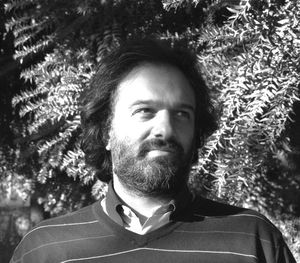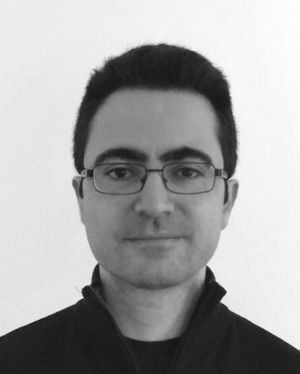The Mathematics of Smoothed Particle Hydrodynamics
January 24, 2019
The Mathematics of SPH
Building 28 • Van Mourik Broekmanweg 6 • 2628 XE Delft
Room 0.E420 Colloquiumzaal • 9:30-12:30
Smoothed Particle Hydrodynamics is a computational methodology to resolve partial differential equations in Lagrangian form with clouds of mass-laden particles. First conceived for astrophysical research in the 1977, SPH has been used ever since to simulate increasingly wicked situations in fluid and solid mechanics where the meshlessness adds explaining power and/or abates operational overheads.
In SPH integral interpolants (kernels) are used to obtain 'smoothed' estimates of continuous operators (force terms) from scattered data (the particles). These estimates of the force terms, in their turn, determine the displacement of the particles according to governing equations. SPH formulations follow the classical chainwork of manipulation of continuous equations, discretization of continuous operators, and algorithmic solution. Additionally, SPH is a compute-intensive methodology, which makes ample use of hardware acceleration on single- and multi-GPU computer systems.
You may refer to Liu and Liu (2010) for a good review of SPH and to Chen at al (2017) for its positioning among mesh-free methods.
For this workshop we have asked two leading researchers from the Institute for Marine Engineering at the National Research Council in Rome (CNR-INR, formerly CNR-INSEAN) to unravel the key mathematical properties, challenges and perspectives of the SPH methodology. Please visit their YouTube channel at https://www.youtube.com/user/SPHInsean to watch some SPH visualizations.
THE TALKS AND SCHEDULE
9:30-10:00 • Walk-in with coffee and tea, and welcome (Kees Vuik, DIAM TU Delft)
10:00-11:00 • Andrea Colagrossi • CNR-INM • Italy
How to derive the Smoothed Particle Hydrodynamics equations in a Lagrangian mechanics framework PDF, 12 MB
After 40 years of studies and developments SPH method is now gaining wide acceptance in different engineering fields. As a matter of fact, the citations of papers tagged as Smoothed Particle Hydrodynamics increased from 2484 in 2007 to 7055 in 2017 (source: WoS). The majority of these publications deal with violent free-surface flows; in this context, this method has also been used successfully by computer graphics studios for special effects in movie sequences. More rigorously, it has been demonstrated that SPH is intrinsically a consistent representation of fluids described as macroscopic systems of discrete particles. This talk will recall the history of SPH, underline the peculiarities and theoretical background of this particle method, and highlight the main differences with other classical mesh-based CFD methods.
11:00-12:00 • Matteo Antuono • CNR-INM • Italy
Stability, accuracy and time-integration issues in SPH schemes PDF, 3 MB
The standard SPH scheme is generally characterized by intense spurious numerical noise that affects the fields of both pressure and density. This phenomenon, mainly caused by the assumption of weak compressibility, leads to poor accuracy in the evaluation of the pressure fields and of loads on solid profiles. A reliable strategy to go round this issue consists in using a suitable diffusive term in the continuity equation of the SPH model. This smooths out the spurious numerical noise and, at the same time, preserves the principal conservation properties of the standard SPH scheme (conservation of mass and of linear and angular momenta, and a correct balance of the energy equation). This talk addresses the main features of the standard SPH and of its diffusive variant, with a specific focus on accuracy, stability and time-integration algorithms. Some perspectives will be outlined, suggesting applications of the diffusive SPH scheme to modelling turbulence in a Lagrangian LES (Large Eddy Simulation) framework.
12:00-12:30 • Round-table discussion and conclusion
THE SPEAKERS

Andrea Colagrossi is a researcher at CNR-INM since 1998. His main area of investigation is the theoretical and computational aspects of mesh-free numerical methods for naval and marine-oriented applications. He is author of 60 peer-reviewed journal articles, totalling 2630 citations in 1288 documents. He has been member of the Steering Committee of SPHERIC (Smoothed Particle Hydrodynamics Research and Engineering Community, an interest group of ERCOFTAC) since 2006. He has received the Joe Monaghan Prize, awarded by the SPH community for outstanding advances on the SPH ‘grand challenges’, in 2015 and 2018.
He is also attached professor at École Centrale de Nantes in France, guest professor at the Harbin Engineering University in China, and Ph.D. examiner at UPM Technical University of Madrid, where he supervises Ph.D. and post-doctoral researchers. At CNR he is manager in international collaborative projects such as NextMuSE (Next generation Multi-mechanics Simulation Environment, FP7) and SARAH (increased Safety And Robust certification for ditching of Aircrafts and Helicopters, Horizon 2020).
He gained a PhD in Theoretical and Applied Mechanics at the La Sapienza University of Rome in 2005.
See

Matteo Antuono is a researcher and a member of the SPH development team at CNR-INM. His scientific interests cover both the theoretical and numerical aspects of particle methods, the propagation of gravity waves, and sloshing motions. He is author of 52 peer-reviewed journal articles, totalling 1,336 citations in 619 publications. He has received the Joe Monaghan Prize, awarded by the SPH community for outstanding advances on the SPH ‘grand challenges’, in 2015 and 2018. He graduated in Applied Mathematics at the La Sapienza University of Rome in 2004, and gained his PhD in Fluid Dynamics at the University of Genoa in 2008.
See PDF-File
REFERENCES
A. Di Mascio, M. Antuono, A. Colagrossi, S. Marrone, Smoothed particle hydrodynamics method from a large eddy simulation perspective, Physics of Fluids 29:035102 (2017)
A. Colagrossi, D. Durante, J. Bonet-Avalos, A. Souto-Iglesias, Discussion of Stokes’ hypothesis through the smoothed particle hydrodynamics model, Physical Review E, 96:023101 (2017)
A. Colagrossi, B. Bouscasse, S. Marrone, Energy decomposition analysis for viscous free-surface flows, Physical Review E, 92:053003-13 (2015)
M. Antuono, S. Marrone, A. Colagrossi, B. Bouscasse, Energy balance in the δ-SPH scheme, Comput. Methods Appl. Mech. Engrg. 289:209-226 (2015)
M. Antuono, B. Bouscasse, A. Colagrossi, S. Marrone, A measure of spatial disorder in particle methods, Computer Physics Communications, 185:2609–2621 (2014)
D. Le Touzé, A. Colagrossi, G. Colicchio, M. Greco, A critical investigation of Smoothed Particle Hydrodynamics applied to problems with free surfaces, International Journal for Numerical Methods in Fluids, 73:660-691, (2013)
M. Antuono, A. Colagrossi, S. Marrone, Numerical diffusive terms in weakly-compressible SPH schemes, Computer Physics Communications 183: 2570-2580 (2012)
A. Colagrossi, M. Antuono, A. Souto-Iglesias, D. Le Touzé, Theoretical Analysis and numerical verification of the consistency of viscous SPH formulation in simulating free-surface flows, Physical Review E, 84:026705 August (2011).
M. Antuono, A. Colagrossi, S. Marrone, D. Molteni, Free-surface flows solved by means of SPH schemes with numerical diffusive terms, Computer Physics Communications 181:532-549 (2010)
A. Colagrossi, M. Antuono, D. Le Touzé, Theoretical considerations on the free-surface role in the smoothed-particle-hydrodynamics model, Physical Review E, 79:1-13 (2009)
N. Grenier, M. Antuono, A. Colagrossi, D. Le Touzé, B. Alessandrini, An Hamiltonian interface SPH formulation for multi-fluid and free surface flows, Journal of Computational Physics 228:8380–8393 (2009)
D. Molteni, A. Colagrossi, A simple procedure to improve the pressure evaluation in hydrodynamic context using the SPH, Computer Physics Communications 180(6):861-872 (2008)
IN-HOUSE AT DELFT
For progress of our in-house research on SPH see
• Twitter https://twitter.com/sph_delft
• Youtube http://bit.ly/sph_tube
• e-mail sph.info@tudelft.nl